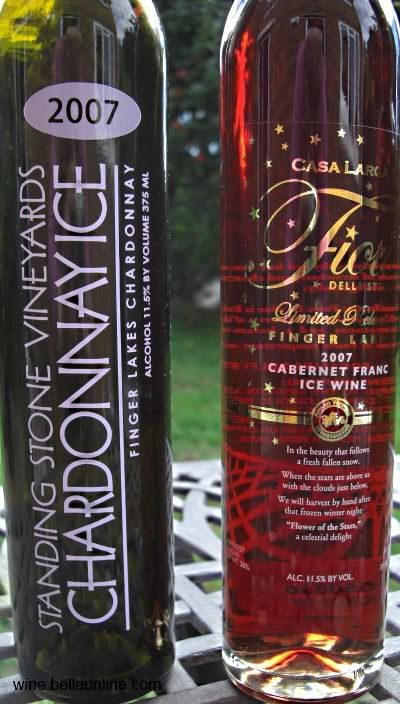What are ICE, ICED and ICEWINES?

 Legend says a remote monastery in Germany was waiting for permission to harvest their grapes. The messenger forgot to call and months passed into winter. Snow began to fall and still the grapes were hanging. When the long delayed authority arrived the monks found the grapes were frozen solid but they went ahead and pressed them. They were delighted to find the resulting wine was the sweetest ever experienced.
Legend says a remote monastery in Germany was waiting for permission to harvest their grapes. The messenger forgot to call and months passed into winter. Snow began to fall and still the grapes were hanging. When the long delayed authority arrived the monks found the grapes were frozen solid but they went ahead and pressed them. They were delighted to find the resulting wine was the sweetest ever experienced. When grapes get extremely cold the water content inside the berry freezes first and pressing them squeezes out the sugar rich nectar, which has a lower freezing temperature, leaving behind diluting water.
History records that such frozen wines were known in Roman times and in the centuries before sugar canes were discovered and honey was the main sweetening agent, the intensely sweet icewines were highly treasured – and very rare.
Icewines are rare because the weather has to drop to a sub-freezing temperature for several consecutive days before picking and this doesn’t happen every year. Also leaving grapes on the vine for so long after normal harvest risks mould and rot spoiling them and birds and animals eating the crop.
Then came the 20th century with the invention of industrial freezers and winemakers anywhere could gain the same effect by picking grapes at the optimum time and freezing them.
Now we can buy ‘natural’ icewine and ‘artificial’ ice wine, but how do you know which is which?
Germany and Canada are the largest producers of natural ice wine (eiswein in German) and are highly regulated. Canada’s VQA rules require at least three consecutive days at below -8° Celsius (17.6°F) before grapes can be harvested.
In the USA New York State makes some ice wine but until recently, because freezer wine could then be called icewine, there was little incentive. The USA has now ruled that only wines made in from grapes frozen on the vine can be labelled 'Ice Wine', adding “if a wine is made from grapes frozen after harvest, any reference that suggests the wine is made from frozen grapes must be qualified with a phrase such as ‘made from grapes frozen post-harvest’.”

Inventive wineries now label freezer wine as just ‘Ice’ or ‘Iced’ and in a tasting room it is impossible to differentiate between someone saying ‘This is our Ice wine,’ and ‘This is our Ice Wine.’ However the price of freezer wine should be less than half the price of natural Ice Wine.
Does it matter? Real ice wine is difficult, risky and costly to make and freezer wine can be made from grapes picked at optimum ripeness. Standing Stone Vineyards owner Marti Macinski says “I think my freezer is better than natural ice wines because grapes are picked in better conditions than grapes left till December.”
Connoisseurs think real ice wine is more complex with subtle flavours gained from grapes increased time on the vine and their very rarity makes them special.
But you have to taste and make up your own mind. Because of its intense sweetness and great cost ice wine comes in half bottles (375mL) and smaller.
I was very impressed with Standing Stone Vineyards ICE Chardonnay freezer wine; Chardonnay grapes are not usually used for natural ice wine. I found that as well as a rich luscious sweetness it had a most complex interesting range of flavours. Standing Stone owner Marti Macinski explained it when she told me that the wine contained about 10% of other varieties growing their experimental vineyard including Pinot Gris, Pinot Meunier and Vidal. ICE Chardonnay costs $24.99 from the East Seneca Lake winery and is worth every cent.
I was stunned by Fiori Cabernet Franc Ice Wine 2007 from Finger Lakes winery Casa Larga in Fairport. This is natural ice wine from grapes frozen on the vine picked at around 18 degrees Fahrenheit (-8C). The black grapes makes a most beautiful orange-pink coloured wine and their intense sweetness has to be experienced. There are hints of strawberry and caramel and the wine is beautifully balanced with enough acidity to tempt you to another glass. Casa Larga Fiori Cabernet Franc Ice Wine 2007 is a world class ice wine which costs $74.99 at the winery. No real ice wine will be inexpensive but this is worth it.

Tips:
- Make sure you know if you are buying natural or freezer ice wine, labelling is confusing but should tell you. If it says ‘ice wine’ and has the Canadian VQA label or it is from an EU country then it is natural.
- Make sure you know how much you are paying because a cheaper price may indicate a smaller bottle. Show are three ice wines, the left one is 375mL, the middle one is 250mL and the one on the right is 50mL.
Peter F May is the author of Marilyn Merlot and the Naked Grape: Odd Wines from Around the Worldwhich features more than 100 wine labels and the stories behind them, and PINOTAGE: Behind the Legends of South Africa’s Own Wine which tells the story behind the Pinotage wine and grape.
Disclosure: The author visited Standing Stone and Casa Larga as a guest of The New York Wine & Grape Foundation.

Related Articles
Editor's Picks Articles
Top Ten Articles
Previous Features
Site Map
Content copyright © 2023 by Peter F May. All rights reserved.
This content was written by Peter F May. If you wish to use this content in any manner, you need written permission. Contact Peter F May for details.


